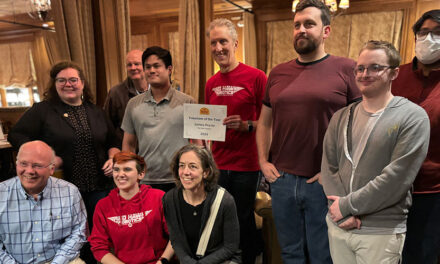Published May 10, 2019
MELROSE — What a difference an extra $5.18 million make.
In her first really upbeat municipal finance address since voters approved a $5.18 million override of Proposition 2 1/2 on April 2, Mayor Gail Infurna said Monday the city is in a good place in part because the proposed city budget reflects the “values” of residents.
Infurna spoke Monday before the annual joint budget meeting of the aldermen and the School Committee. Her administration is proposing an $86,662,988 spending plan for the year beginning July 1. That total includes a city commitment to Melrose’s public school system of $32,338,667, an increase of 17.2 percent over the current year.
Following is the mayor’s address:
One year ago, when I gave my Fiscal 2019 budget address, I came before you with serious concerns about the city’s finances. Today, I am happy to present a budget that is both balanced and sustainable.
Instead of a budget that cuts millions of dollars from city services, this budget is balanced and maintains the current level of services in our library, our Council on Aging, Memorial Hall, our police department, and other services that our residents depend on.
This is possible because just four weeks ago, the citizens of Melrose voted to pass the override, giving us the opportunity to stabilize the school budget and meet the needs of our growing student population, which in turn has saved our community from drastic cuts to city services.
Let me say first of all, that I am grateful to the community for their engagement in the override discussion. They learned about our budget process, they participated in the questionnaire, the listening forums, and the question and answer sessions we held, and they even stopped me on Main Street to tell me they had read my blog and our newspaper articles. And finally, they made the choice to invest in the future of Melrose.
I am also grateful to the department heads and all our city employees for their dedication and professionalism during this period of extreme uncertainty. While we were asking them to look at worst-case scenarios and figure out what services would have to be eliminated with severe budget cuts, they also continued to manage the daily operations of the city. They put in countless hours, making sure that our residents did not see any interruption in service, while taking on the extra burden of determining what could and could not be cut.
Tonight, the picture is much brighter than it was a year ago. This budget will include the funds we need to move our schools forward.
• We will be able to return the district to full staffing levels at the middle school and the high school and hire additional staff to accommodate our growing enrollment
• We will be able to pay for the equipment and infrastructure we need to accommodate our new students
• And we will be able to improve teacher pay and teacher retention.
On the city side of the budget, you will see that services have been for the most part level-funded. We have been able to add a critically needed school nurse position at the middle school/high school campus and a custodian for the library. In addition, this budget includes full funding for the police and fire contracts.
I will make a recommendation to this board that you make no increase to water volumetric rates, as well as sewer volumetric rates, and water base fees this year, and that you make a slight adjustment to the sewer base fee which translates into approximately $5 per quarter on the average water bill. We are able to stabilize these rates because of the many years of hard work on the part of the Water and Sewer Rate Committee and this board. In the upcoming months, we will continue to invest in our water and sewer infrastructure, using MWRA interest-free loan programs to reduce leaks into and out of the system.
We will continue to review the city budget, looking for areas where we can manage our resources more effectively. This year, we did a survey of all the city’s vehicles, from police cruisers to DPW trucks, so we can set up a replacement schedule that will save us money on both purchases and repairs.
I’m also excited to announce that the Capital Improvement Planning Committee will reconvene this month with John Tramontozzi as the Aldermanic representative and Chairman Ed O’Connell representing the School Committee. This committee will look at all of our capital needs throughout the city, including school buildings, roofing projects, windows and such, so we can prioritize our capital projects.
As you know, the override closed the funding gap in our schools that had existed for years, which forced us to use one-time money to fund the school budget. We will now be able to tackle critical city vehicle needs and pay for them with one-time money, which is the right way to do it.
We will continue to explore ways to bring in new revenue, but here is what we are not going to do. We are not going to support a 40B project dropped into green space far from public transit.
Please allow me a little leeway here: In the past, I have supported smart growth developments that have brought in additional revenue without impacting the environment. However, I want to make it very clear that I do not support the proposed 40B development off Swains Pond Avenue. This is not beneficial to our city or to the current residents. The potential new residents would be isolated from public transit and unable to enjoy living in a walkable city.
We will continue to seek out responsible development, and by that I mean development that makes sense for this city and does not encroach on green space or destroy wetlands.
Here are a few of the other ways in which we will continue to seek out new sources of revenue:
• We will continue to seek outside funding for projects such as the Complete Streets program.
• We will continue to encourage our department heads to apply for grants throughout the fiscal year.
• We will continue to look at green energy initiatives.
• We will continue to explore opportunities for regionalization.
• We will also continue to work with MelroseWakefield Healthcare, which has made a number of investments in this community over the years.
While we anticipate additional revenue from recreational marijuana, we have not included it in the budget because we don’t have any data to make projections.
In my State of the City address in January, I spoke of the ways in which our budget was no longer matching our values. We were funding the schools at the bare minimum required by the state. Experienced teachers were leaving the school system, and the art supply budget had been cut to $6 per student. Our library was in danger of losing accreditation if we reduced its funding any further. We were unable to meet the infrastructure needs of our city. I used the analogy of a house that shows more and more signs of neglect over the years: The grass becomes overgrown, the paint starts to peel, a window is broken, and soon it is in disrepair.
Today, I am proud to say that our house is in order. Today, our budget does match our values. Today we are able to provide the School Department with the funds they need, and with our budget stabilized, we are able to look positively to the future.




